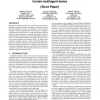ATAL
2008
Springer
14 years 2 months ago
2008
Springer
As virtual characters become more autonomous, their use in interactive drama is growing. By creating interesting and well authored personalities, these characters are able to inte...
ATAL
2008
Springer
14 years 2 months ago
2008
Springer
We present a logic for reasoning about properties of agent programs under different agent execution strategies. Using the agent programming language SimpleAPL as an example, we sh...
ATAL
2008
Springer
14 years 2 months ago
2008
Springer
Most current crowd simulators animate homogeneous crowds, but include underlying parameters that can be tuned to create variations within the crowd. These parameters, however, are...
ATAL
2008
Springer
14 years 2 months ago
2008
Springer
Behaviors in soccer-agent domains can involve individual plays, several players involved in tactical plays or the whole team trying to follow strategies supported by specific form...
ATAL
2008
Springer
14 years 2 months ago
2008
Springer
This research explores productive multi-player games as a platform for human-computer agent collaboration. A multiagent perspective is taken to examine the principles of both game...
ATAL
2008
Springer
14 years 2 months ago
2008
Springer
The advent of virtual environments such as SecondLife call for a distributed approach for norm emergence and spreading. In open virtual environments, monitoring various interactin...
ATAL
2008
Springer
14 years 2 months ago
2008
Springer
Multi-Agent Reinforcement Learning (MARL) algorithms suffer from slow convergence and even divergence, especially in large-scale systems. In this work, we develop a supervision fr...
ATAL
2008
Springer
14 years 2 months ago
2008
Springer
When human-multiagent teams act in real-time uncertain domains, adjustable autonomy (dynamic transferring of decisions between human and agents) raises three key challenges. First...
ATAL
2008
Springer
14 years 2 months ago
2008
Springer
Effective teamwork in highly dynamic environments requires a delicate balance between giving agents the autonomy to act and react on their own and restricting that autonomy so tha...
ATAL
2008
Springer
14 years 2 months ago
2008
Springer




